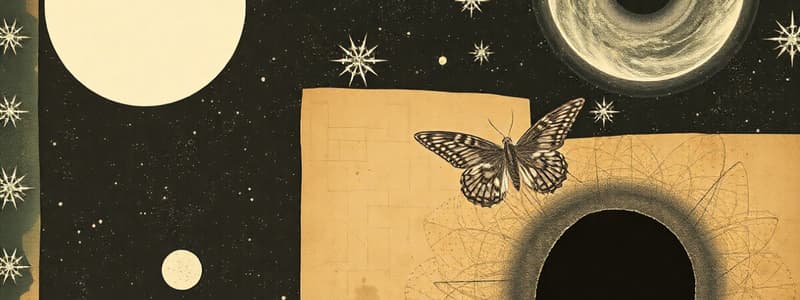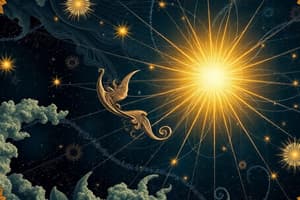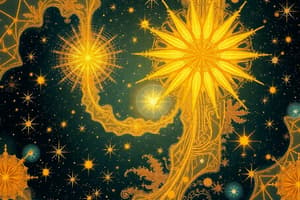Podcast
Questions and Answers
What phenomenon occurs as an object approaches a black hole?
What phenomenon occurs as an object approaches a black hole?
- Time appears to run more slowly for the object. (correct)
- The object's mass decreases significantly.
- The object emits bright visible light instead of redshifted light.
- The object appears to move faster than light.
What is a likely cause of gamma-ray bursts?
What is a likely cause of gamma-ray bursts?
- Unusually powerful supernova explosions. (correct)
- Internal reactions in neutron stars.
- Collisions between planets.
- The explosion of weak stars.
What process occurs when two neutron stars in a binary system merge?
What process occurs when two neutron stars in a binary system merge?
- They split into smaller neutron stars.
- They form a black hole with no gravitational waves emitted.
- They produce a supernova explosion that destroys both stars.
- They emit gravitational waves as their orbital distance decreases. (correct)
How do black holes provide evidence of their existence?
How do black holes provide evidence of their existence?
What element is primarily produced from mergers of neutron stars?
What element is primarily produced from mergers of neutron stars?
What provides support against the gravitational collapse of a white dwarf?
What provides support against the gravitational collapse of a white dwarf?
What phenomenon may occur when a white dwarf in a close binary system undergoes nuclear fusion?
What phenomenon may occur when a white dwarf in a close binary system undergoes nuclear fusion?
What is a defining characteristic of neutron stars?
What is a defining characteristic of neutron stars?
How were neutron stars first detected?
How were neutron stars first detected?
What happens when a neutron star in a close binary system accretes hydrogen?
What happens when a neutron star in a close binary system accretes hydrogen?
What defines a black hole's size?
What defines a black hole's size?
What phenomenon can occur if you approach a black hole?
What phenomenon can occur if you approach a black hole?
What emerges from the collapse of the iron core of a massive star?
What emerges from the collapse of the iron core of a massive star?
Flashcards
White Dwarf
White Dwarf
The core left over from a low-mass star, supported by electron degeneracy pressure.
White Dwarf Nova
White Dwarf Nova
A sudden brightening of a white dwarf system due to hydrogen fusion on the surface.
Neutron Star
Neutron Star
A dense ball of neutrons, formed by the collapse of a massive star's core in a supernova.
Pulsar
Pulsar
Signup and view all the flashcards
Neutron Star X-ray Binary
Neutron Star X-ray Binary
Signup and view all the flashcards
Black Hole
Black Hole
Signup and view all the flashcards
Event Horizon
Event Horizon
Signup and view all the flashcards
Schwarzschild Radius
Schwarzschild Radius
Signup and view all the flashcards
What causes gamma-ray bursts?
What causes gamma-ray bursts?
Signup and view all the flashcards
What happens when neutron stars merge?
What happens when neutron stars merge?
Signup and view all the flashcards
What happens when black holes merge?
What happens when black holes merge?
Signup and view all the flashcards
Black Hole Evidence
Black Hole Evidence
Signup and view all the flashcards
Redshifting near Black Holes
Redshifting near Black Holes
Signup and view all the flashcards
Study Notes
White Dwarfs
- White dwarfs are the remnants of low-mass stars.
- They are supported by electron degeneracy pressure.
- They have the Sun's mass compressed into the size of Earth.
- In close binary systems, white dwarfs can accrete hydrogen from a companion.
- Accretion can trigger novae, shining intensely for weeks.
- Extreme accretion or mergers can lead to white dwarf supernova explosions.
Neutron Stars
- Neutron stars are created from the collapse of iron cores in massive star supernovae.
- They are extremely dense with a radius of about 10 kilometers.
- They have a mass greater than the Sun.
- Neutron stars' rapid spin and strong magnetic fields produce pulsars.
- Pulsars are the first direct evidence of neutron stars.
- In close binary systems, neutron stars accrete hydrogen from their companions.
- This accretion creates hot accretion disks, detectable as x-ray binaries.
- Helium fusion on the neutron star's surface can cause X-ray bursts.
Black Holes
- Black holes are regions of spacetime with gravity so strong that nothing can escape, not even light.
- The boundary is the event horizon.
- The size is described by the Schwarzschild radius.
- Orbiting a black hole would be similar to any other massive object.
- Observing objects falling into black holes reveals time dilation and redshift.
- Objects disappear from view as light becomes too redshifted to detect.
- Black holes are predicted by theory and observed via X-ray binaries.
- No force can stop the collapse of stellar corpses with masses exceeding neutron star limits (2-3 solar masses).
Extreme Events
- Gamma-ray bursts are powerful explosions in distant galaxies.
- They are likely due to very powerful supernovae, creating black holes.
- Short gamma-ray bursts may result from neutron star mergers.
- Neutron star mergers produce gravitational waves and potentially heavy elements (gold, platinum, uranium).
- Black hole mergers also produce gravitational waves (detected).
Studying That Suits You
Use AI to generate personalized quizzes and flashcards to suit your learning preferences.





